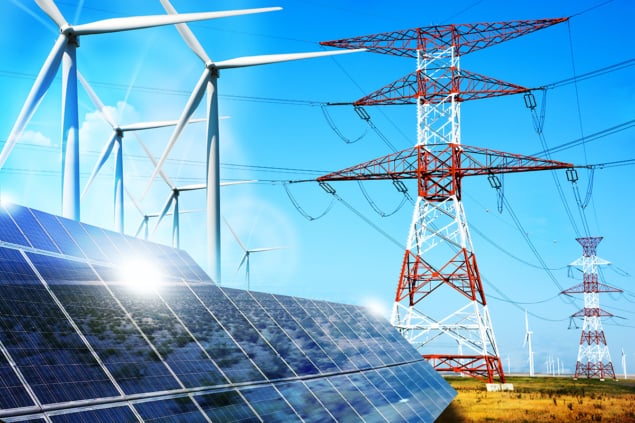Dave Elliott says that, while renewable energy has rapidly progressed over the past decade, more needs to be done to help limit the impact of climate change

“The country that harnesses the power of clean, renewable energy will lead the 21st century.” So said former US President Barack Obama in 2009. At the time, renewables such as wind and solar power were just getting off the ground with around 160 GW of wind capacity and just 21 GW of solar photo-voltaics (PV solar) in place worldwide.
Since then, the costs of renewables have fallen dramatically – by 76% in the case of PV solar. The boom has been aided by concerns about the impact of climate change as well as by rampant air pollution, particularly in some Asian cities. And the costs continue to fall. Indeed, they are now the cheapest power option in most places.
Global renewable energy capacity hit 2351 GW by the end of 2018, accounting for a third of the world’s total power capacity and supplying over 26% of global power. In the UK, the overall share of renewables in power generation has increased to over 33% – a figure that is set to rise as new offshore wind projects come online. The share of renewables in Portugal is over 54% while in Denmark it is near 60% and Sweden has reached 66%. Interestingly, renewable energy accounted for 70% of electricity production in Scotland in 2017.
The Norwegian energy firm DNG-GL forecasts an 80% share of power generation by 2050 for renewables, while the International Renewable Energy Agency (IRENA) says it could be more like 86%. That may be too much for some countries, however, as the ongoing energy transition means a host of political and economic issues.
As ever, there are doubters who say the whole renewable agenda is ill-conceived and that renewables cannot deliver on the scale and pace necessary to cut emissions. Part of the problem is that, in some locations, energy demand is rising and so is -fossil energy use. This leads to a lowering of the renewable share percentage, followed by a rise in emissions, which is likely to get worse unless urgent action is taken. Despite the potential, the short-term prognosis does not look too good. Renewable investment levels have recently reduced and annual capacity expansion has stalled.
This is partly because costs are decreasing and the profit margins on new projects are falling. It is possible to get more output and better returns from less money. Competition has also led to a “race to the bottom”, also known as the “market-cannibalization” effect whereby only the cheapest projects are funded.
Globally – in capacity and investment terms – China is the clear leader in renewables with over 720 GW. But faced with delays in matching its power-grid expansion to its renewables expansion, China has reduced its rate of investment in renewables. Yet the global slowdown seems unlikely to affect the overall cumulative global expansion process. Indeed, the International Energy Agency (IEA) forecasts that the share of renewables in global power generation will rise from 26% today to 30% by 2024. Global renewable power capacity could grow by 50% between 2019 and 2024 – an increase of 1200 GW – but even this might not be fast enough to meet climate change goals.
The IEA says we therefore need to go faster both with renewable and, crucially, with energy saving and demand reduction. Demand for electricity has actually fallen in recent years in 18 out of 30 IEA member countries. However, demand for other types of energy is rising, especially for transportation. But if this is decarbonized by switching to electric vehicles, for example, electric power demand may start rising again.
Some are still optimistic for the future of renewables. IRENA states that renewables could be able to supply 50% of all global energy – not just electricity – by 2050. Studies in the US, Germany and elsewhere even claim that renewables could supply 100% of all global energy by 2050. That may be technically possible and even economically attractive, but it would certainly require new investment in hardware and back-up systems, and in new technology for both. Flying the flag for wind energy
The IEA notes that R&D on renewables has expanded significantly in recent years and is now roughly similar to nuclear. Overall, global investment in clean-energy technology has been running at $300bn or more per year in recent years while that for nuclear fell to a new low of $17bn last year. Nuclear is not zero carbon and it seems to have stalled or declined in many places.
However, we need more carbon-free energy investment – and fast. One way to raise more money for accelerating renewables is by carbon taxes and the creation of a global carbon market. But this might not be enough and we may need a more radical energy and economic transition – one that includes implementing new economic models and patterns of energy use.
The longer-term benefits of renewables are substantial, not least helping to avoid the ever-increasing social, environmental and economic costs of fossil fuel. Given the political will and continued technological development, including energy storage, grid balancing and demand-management systems, I believe that renewables can help us all move to a sustainable energy future.
- Read more about the current status of renewable energy in Dave Elliott’s recently updated and expanded ebook Renewables, published by IOP Publishing. He blogs at https://renewnatta.wordpress.com/



